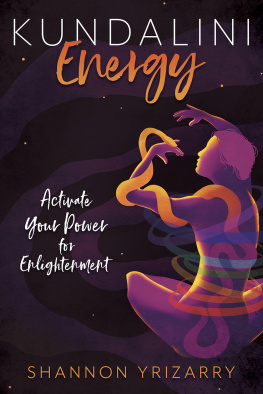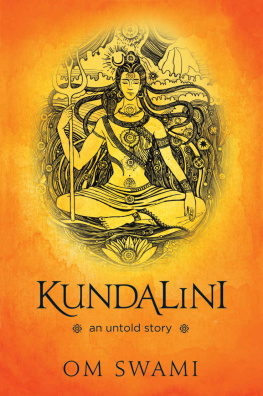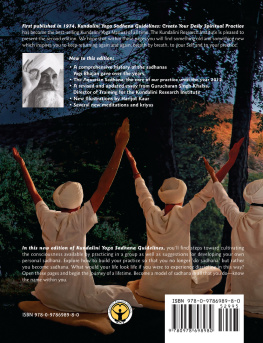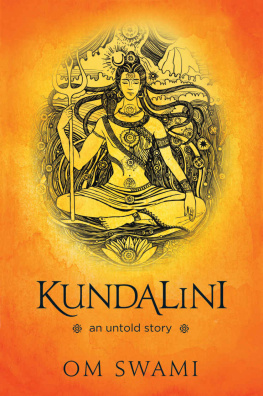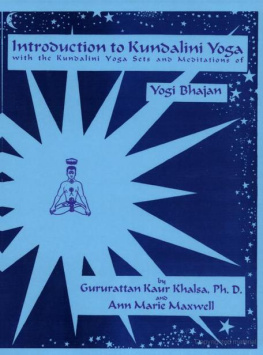Introduction
TAMI SIMON
In 1984, I needed the book Kundalini Rising, and it didnt exist. I was twenty-two years old and I had just returned home from participating in a series of intensive meditation retreats in Sri Lanka, India, and Nepal. I was in a very strange condition (at least I thought it was strange). I had developed a case of the shakes, which meant that my body would twitch and contort of its own accord. The shakes would get worse whenever I meditated, to the point where I would find myself shaking and then twisting into weird positions during sitting practice. I consulted with various teachers, and I was told that what I was experiencing was the natural releasing of blocked energy in the body. I should simply relax and let the process unfold. A couple of meditation teachers mentioned that what I was experiencing was sometimes associated with kundalini beginning to awaken in the body, and again, I should just relax.
Relax? I wanted to know everything there was to know about kundalini. Was it a good or bad sign that I was shaking and contorting? Why did some people say that the awakening of kundalini could be dangerous? Why was kundalini so often compared to a snake coiled at the base of the spine? Was the rise of kundalini just a metaphor, and if so, a metaphor for what transformative process?
What I discovered at the time was that there were few comprehensive resources available on the topic of kundalini. Mostly what I found were yogic texts that had been translated from Sanskrit and felt to me ancient and distant, their meaning hard to decipher. I also found some individual accounts of kundalini awakenings that were quite fascinating to read but didnt help me contextualize or map the process in a way that enabled me to understand my own experience. What I wanted was a contemporary resource guide, a book on kundalini that could help me understand the experience in Western language and from many different vantage points.
Here is the book I wish Id had twenty-five years ago. Gathered into one volume, Kundalini Rising comprises twenty-four essays on different aspects of the kundalini experience, including what transpersonal psychologists have to say about kundalini; understanding the yogic brain from a scientific perspective; the relationship between near-death experiences and kundalini awakening; understanding the relationship between kundalini energy and sexual energy; yogic exercises to catalyze the kundalini process; the role that kundalini awakening plays in the unfolding of our highest human potential; and more.
It is now time for our understanding of kundalini to be broad and multi-disciplined, for our discussions about kundalini to come out of the realm of esoterica and to enter ordinary discourse. The primary reason for this is that more and more of us are experiencing spiritual awakenings of all kinds, identity-shattering experiences that leave us open to the mystery of being beyond name, shape, or form. These intense experiences re-wire us; they bring with them changes not just in our mental self-structure (our mental sense of who we are) but in our energetic self-structure (our felt sense of who we are). When we experience intense spiritual openings, movements and changes occur in our subtle body; at the energetic level of our being, kundalini begins to stir, and rise.
It is my belief that kundalini is on the rise, literallythat more and more people are having experiences of spiritual awakening. I base this belief on reports that I hear from contemporary spiritual teachers along with the increased public acceptance and growing popularity of practices such as meditation, energy healing, and kundalini yogaall practices that are designed to dissolve our solid sense of self and open us to the transformative power of awareness. Such spiritual awakenings are inevitably accompanied by openings in the energetic channels of the body. It is as if our physical body, our energetic body, and our sense of boundless being are all synced up, interpenetrating and affecting one another in every way.
While kundalini is most often associated with the snake (the term itself is Sanskrit for that which is coiled), in traditional Hindu mythology, kundalini is sometimes referred to as a goddessa fierce and powerful energy that works according to her own sense of timing and the evolutionary needs of the situation. Her movement through the body can be thunderous, destroying whatever energetic attachment is obstructing her free flow.
When this energy began to awaken in me, I felt afraid. (All these years later I sometimes still shake during meditation, but the good news is that I no longer feel worried when this happens.) What I have since learned is that the experience of shaking and involuntary movements (called kriyas in yogic literature) is a perfectly normal part of the awakening process. Kundalini is intense energy moving through the body and clearing out energetic blockages. There was never any reason for me to be panicked or afraid. And yet at the time, I lacked information. My hope is that this collection of essays on kundalini rising will help demystify the kundalini experience for you, providing you with the helpful information and contextual understanding you need to support your own process.
I have one further hope for this collection of essays. It is my experience that reading about kundalini can actually help catalyze the awakening process. It is as if once we understand the energy that lies within us and the pathways through which it can travel in our subtle body, we have an ability to visualize and flow with the process with heightened sensitivity. May Kundalini Rising help activate this natural unfolding of our expanded human potential in you, for the sake of the whole.
PART I
The Experience
Personal Accounts and Findings from Those Who Have Experienced Kundalini
Kundalini and the Mystic Path
DOROTHY WALTERS, PHD
In l981 at the age of fifty-three, Dorothy Walters experienced intense and spontaneous kundalini awakening, and the subsequent unfolding has been the center of her life ever since. With little preparation and with no external guide or mentor to lead her, she followed the promptings of her inner guru, or what she calls Kundalini consciousness, which led her safely through the many challenges she faced, including episodes of extreme bliss as well as pain. She describes her awakening experience, along with reflections on the kundalini process, in her book Unmasking the Rose: A Record of a Kundalini Initiation.
Now, amazed by how rapidly kundalini awareness and awakening are occurring throughout the world, Dorothy strongly believes that we are in the midst of planetary initiation into a new level of consciousness, with kundalini as the primary engine for this evolutionary leap. A retired professor and author of Marrow of Flame: Poems of the Spiritual Journey and A Cloth of Fine Gold: Poems of the Inner Journey, she shares her experience in the following essay, which begins and ends with two of her poems. Here, Dorothy introduces such questions as: Does kundalinis activation of bliss and awareness, doubt and pain prepare us for another level of conscious development? Do we all have the ability to experience kundalini?



